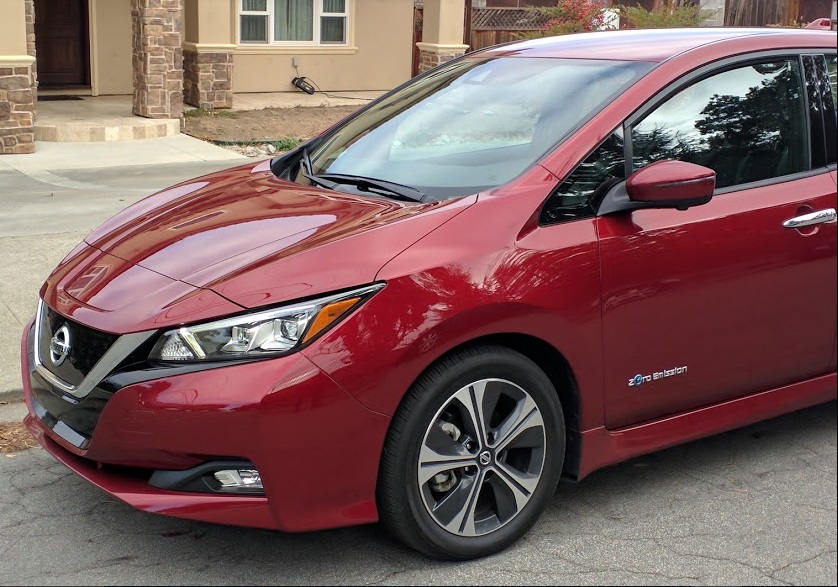
2018 Nissan Leaf electric car, test-driven by Shiva of Fremont, California, Oct 2017
First sales of the 2018 Nissan Leaf, the second generation of the pioneering electric car, should come this month.
But Nissan has quietly been showing the 2018 Leaf to electric-car shoppers for several months now, hosting drives at dealerships and other venues.
Several of our readers and contributors have now taken part in these events, and now we have a first-hand report from one such attendee.
DON'T MISS: 2018 Nissan Leaf electric car now rolling off lines in Tennessee
Our reader and frequent commenter Shiva, who owns a 2012 Leaf and a Tesla Model S, received that opportunity in October.
He attended an official "unveiling" event for current Leaf owners living in Silicon Valley.
What follows are his words about the 2018 Nissan Leaf, lightly edited by Green Car Reports for clarity and style.

2018 Nissan Leaf
Nissan not only held the official event, but also let owners schedule test drives.
So the company brought the new 2018 Leaf to our house during Veteran’s Day Weekend, well before it hits U.S. showrooms and goes on sale in January 2018.
As a current owner of a 2012 Leaf SL, I was eager to see the changes and upgrades in the new 2018 Leaf before making a decision for my family on whether we would lease one.
CHECK OUT: Configuring a Tesla Model 3: buyer walks through the process with us
Exterior
The 2018 Leaf that appeared was even maroon, as our old car is. It has a refreshed exterior that no longer has the “frog” look to the front end. It’s also lower and sleeker to help improve efficiency and aerodynamics.
The “floating” roof design is highlighted by an available two-tone paint option on the SV and SL versions.
The charging port has been moved up on the hood, higher than the previous charging-port door that sat where you'd expect a center “grill” of the old Leaf, complete with Nissan logo. This makes for less effort in bending down for the drive to plug in the car.
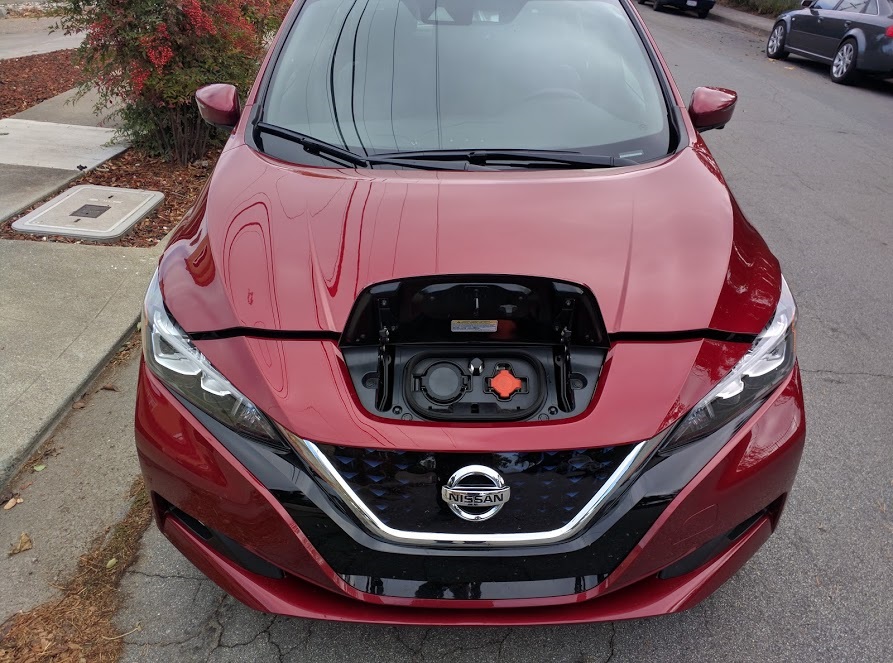
2018 Nissan Leaf electric car, test-driven by Shiva of Fremont, California, Oct 2017
Both the floating roof and higher charging-port door are features Nissan touts as new and improved.
As the Nissan rep confirmed, this “new” Leaf is really a refresh, as the understructure from the windshield to the roof pillars is the same (as the Leaf specialist confirmed during the test drive).
Bearing Nissan’s signature front grille, the Leaf easily blends into the Nissan family now.
READ THIS: One electric car owner's experiences in adding solar panels: why, what, and how
Interior
The steering wheel still doesn't telescope—it only tilts—which is a negative for tall drivers like me, since the steering wheel practically touches my knees.
This is the same as the current Leaf, but Nissan chose to not change this. I'd question that decision.
The driver’s seat is very comfortable with thick padding and controls to find a comfortable fit. This is definitely an upgrade from the current Leaf.

2018 Nissan Leaf electric car, test-driven by Shiva of Fremont, California, Oct 2017
The SL trim level includes power adjustment for the driver’s seat, with a two-way adjustable lumbar support. This is standard on the SL, and optional on the SV trim as part of the technology package.
In terms of materials, there are mostly hard-touch plastics, as in the current generation. The front-door armrests and upper panels by the window switches have softer surfaces, however.
Metallic accents over the glove box, and a two-tone leather option available in the SL trim, give a more premium feel than in the outgoing Leaf.

2018 Nissan Leaf electric car, test-driven by Shiva of Fremont, California, Oct 2017
Nissan moved the power on/off button for the car away to the bottom of the central display from its former position next to the steering wheel, which I found annoying.
Besides the unusual omission of the telescoping steering wheel, Nissan is not making heated rear seats available at all in the 2018 Leaf.
This despite the outgoing Leaf offering standard heated rear seats in all trim levels, with a heated steering wheel standard on the SL trim (our 2012 SL model has this).
The parking brake has been changed to an electric switch in front of the central drive-model knob, as in the earliest 2011 and 2012 Leafs built in Japan.
U.S.-built 2013 through 2017 models got a cheaper pendant parking brake lever hanging under the dash to the left of the brake pedal.

2018 Nissan Leaf electric car, test-driven by Shiva of Fremont, California, Oct 2017
Infotainment
The new Leaf finally has Android Auto and Apple CarPlay compatibility, which is something many of its competitors have already been offering.
However, I find the screen size to be small and the system to be not nearly as responsive as I'd like. The user interface simply feels outdated for a 2018 car that starts around $30,000.
If this were my car, I would avoid Nissan’s system entirely, relying on Android Auto or Apple CarPlay for their ease of use.
Another change: an analog speedometer sits to the right of the digital instrument-cluster display, whereas the first-generation Leafs had an entirely digital display.

2018 Nissan Leaf electric car, test-driven by Shiva of Fremont, California, Oct 2017
Safety Features
The 2018 model finally gets a full array of standard and optional active-safety features. Automatic emergency braking is now standard on all trims, for instance.
The $2,200 tech package on the SV trim adds additional safety features, including high-beam assist, blind-spot warning, rear cross-traffic alert, active lane control, and Pro-Pilot assist. Most of these are standard on the top-end SL trim.
Pro-Pilot is a form of advanced adaptive-cruise control. Besides automatically accelerating, decelerating, and braking in stop-and-go traffic, the system uses radar and a frontal camera to stay centered in a lane.
The auto-braking part of its adaptive-cruise control function works on speeds up to 90 mph. It’s not as advanced as Tesla’s Autopilot system, as it won’t automatically change lanes for you if you activate the turn-signal level, while a Tesla will.
Once you've manually changed lanes, the system automatically engages the lane-keeping function and beeps to let you know it’s activated again.
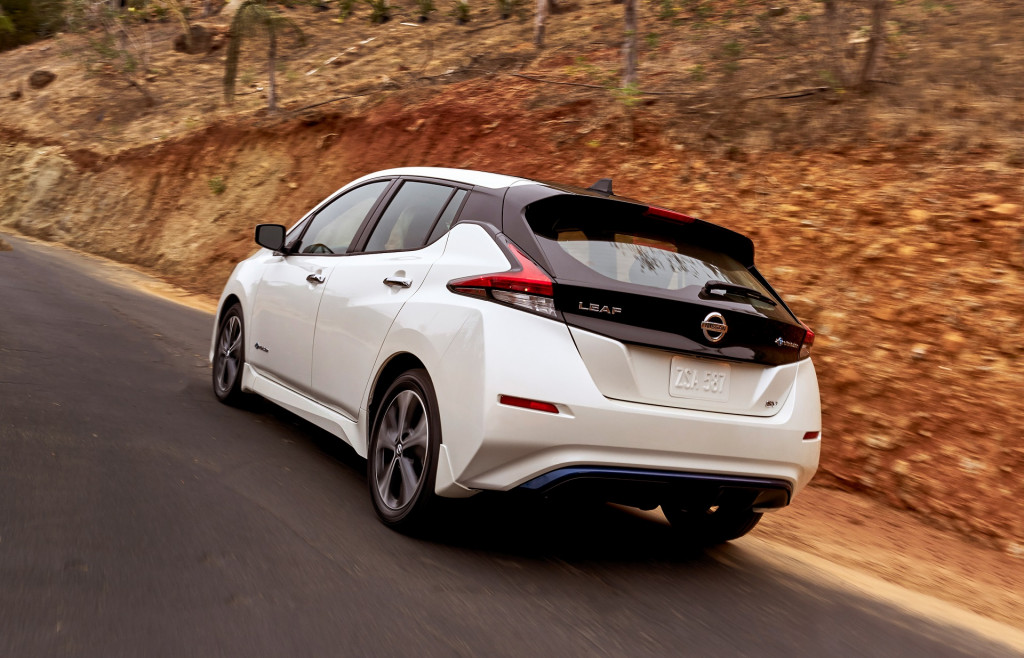
2018 Nissan Leaf
Driving Dynamics
What Nissan calls an E-pedal is standard on all trims; it provides more aggressive regenerative braking during regular driving, both to increase overall efficiency and help the driver to avoid pressing the brake pedal in most situations.
There is switch for the E-pedal near the central shift knob that keeps it activated, so you don’t have to switch on that mode each time the car is turned on.
The system also has automatic hill-holding, which keeps the car from rolling forward or backward after the brakes are applied on a hill. This is a helpful feature in my hilly neighborhood!

2018 Nissan Leaf electric car, test-driven by Shiva of Fremont, California, Oct 2017
Performance
Acceleration from 0 to 60 mph is improved to 8.3 sec, according to Nissan, and I could definitely feel the difference from the first generation.
The 2012 Leaf’s acceleration quickly tapered off above 30 mph, especially at freeway speeds, and it lacked passing power. In the new car, I could definitely feel a difference in the acceleration between 40 and 60 mph.
The Leaf has gone from being poor to being adequate in this regard. It still doesn’t have the off-the-line acceleration of the Chevrolet Bolt EV, or the nimbleness and fun driving dynamics of an a Volkswagen e-Golf or a BMW i3.
But it does feel better in corners and is less appliance-like than my current car—and it retains the same smooth and quiet ride current Leaf owners are used to.
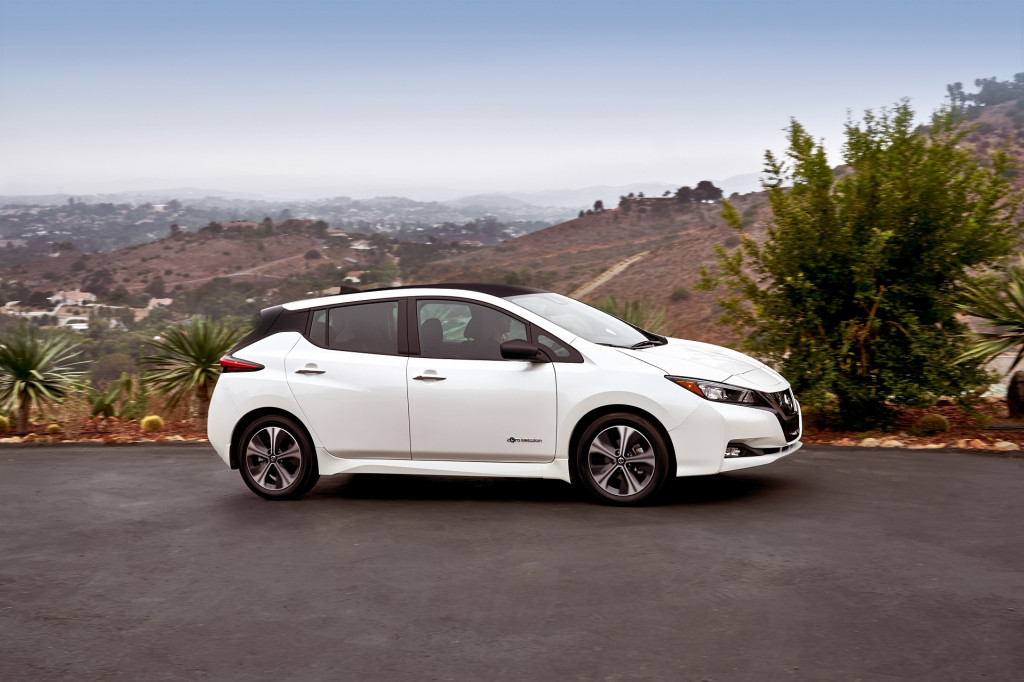
2018 Nissan Leaf
Charging
The onboard charger now operates at 6.6 kilowatts on all trims, just slightly faster than the current 6.0 kW onboard charger. A CHAdeMO quick-charging port is optional on the low-end Leaf S, standard on the higher SV and SL trims.
The Leaf SL also comes with a dual 120-volt/240-volt charging cable now, similar to what Tesla has offered with its models for a while now (though Tesla's onboard charger is faster).
While the 2018 Nissan Leaf isn't the first lower-priced electric car to offer this feature, it's likely the first one that will sell in high volumes.
BUT, NOTE THIS: Dual-voltage electric-car charging cords: plug confusion for 240 volts?

2018 Nissan Leaf electric car, test-driven by Shiva of Fremont, California, Oct 2017
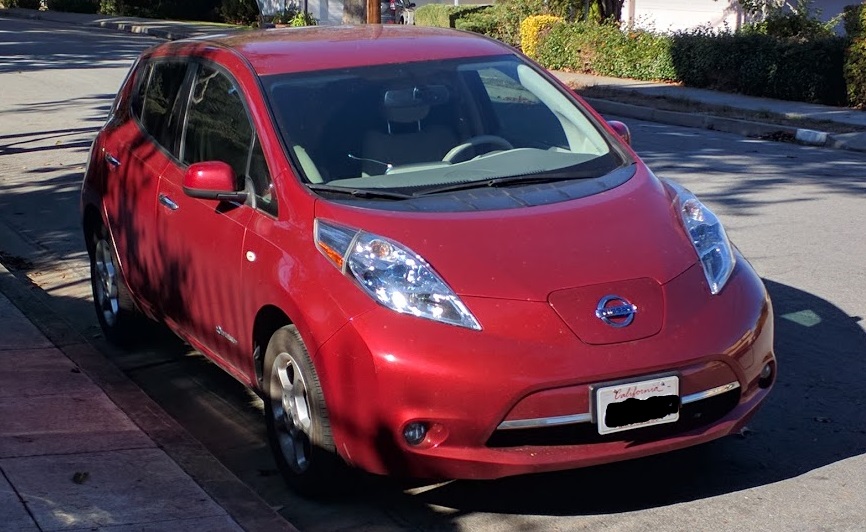
2012 Nissan Leaf SL electric car, owned by Shiva of Fremont, California, Oct 2017

2018 Nissan Leaf electric car, test-driven by Shiva of Fremont, California, Oct 2017

2012 Nissan Leaf SL electric car, owned by Shiva of Fremont, California, Oct 2017
Battery and range
Nissan now says the EPA-rated range will be at least 150 miles from the new Leaf's 40-kilowatt-hour battery, and the official EPA rating should be out very soon.
That's an increase of at least 43 miles from the outgoing 2017 model, rated at 107 miles with a 30-kwh battery. Our 2012 is rated at 73 miles from its early 24-kwh battery pack.
(A long-range version enabling over 200 miles of range is promised to arrive for 2019.)
Nissan still isn't using a liquid-cooled battery for the 2018 model, which uses higher-capacity cells in a pack almost identical in format to that of the earlier versions. Like the current Leaf, in fact, there isn’t even forced-air cooling using a fan.
That may be a big negative for current Leaf owners like me, as the degraded battery of our 2012 Leaf has lost a significant amount of its original rated range.
The 200-mile version of the Leaf is rumored to have active liquid-cooling for better performance. This is something Nissan insiders and owners discussed in detail at the unveiling event I attended, and it's clearly top of mind.
Nissan offers a warranty covering loss of battery capacity below 66 percent over eight years or 100,000 miles, as it does for the 30-kwh pack in the first-generation Leaf.

First 2018 Nissan Leaf produced at assembly plant in Smyrna, Tennessee, Dec 2017
Pricing
The base 2018 Nissan Leaf S starts at $30,875 including the mandatory delivery fee.
A fully-loaded Leaf SL with Bose premium sound, around-view monitor, leather, and the ProPilot Assist system goes as high as $37,085.
The closest competitor to this Leaf is the Ioniq Electric, another compact electric hatchback offering 124 mi of range and similar features at a similar price (starts at $30,385). Another competitor is the 125-mile Volkswagen e-Golf.
All three vehicles remain eligible for the $7,500 federal income-tax credit, though Nissan's credits will start to run out in perhaps two or three years.
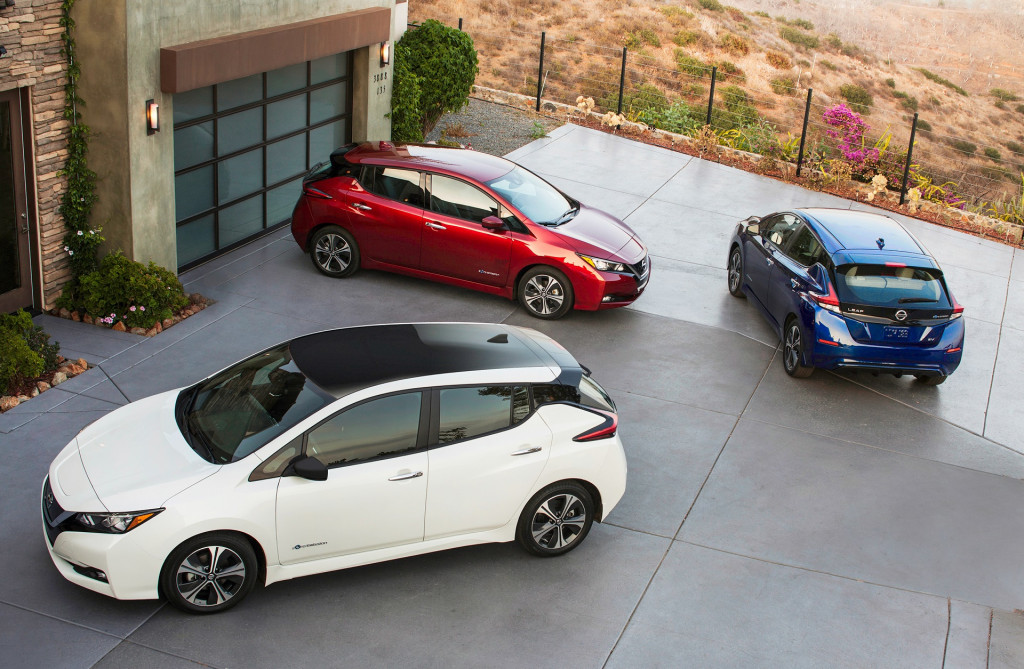
2018 Nissan Leaf
Conclusion
The new 2018 Nissan Leaf represents an evolution of the first mass-market electric car, but not a revolution.
However, the higher range, added features, and general updates should bring new buyers with longer commutes or who were turned off previously by the low rated range around 100 miles and possibly by the unusual styling.
In my opinion, Nissan should have come out of the gate with a version offering more than 200 miles.
The mid-range version I test-drove is a lease-only option for me, considering the higher-range version with rumored active cooling and better performance will come out soon.
_______________________________________













